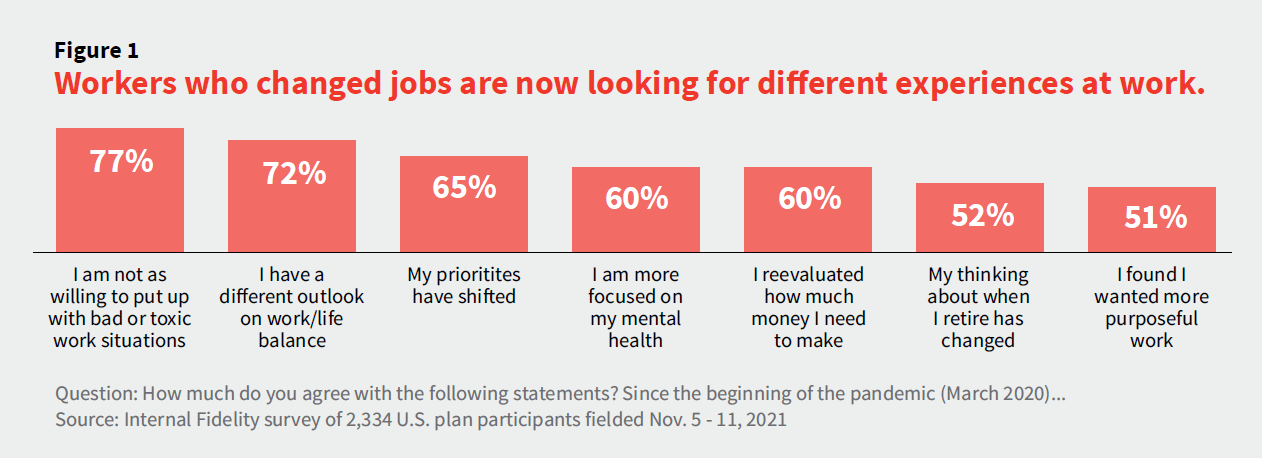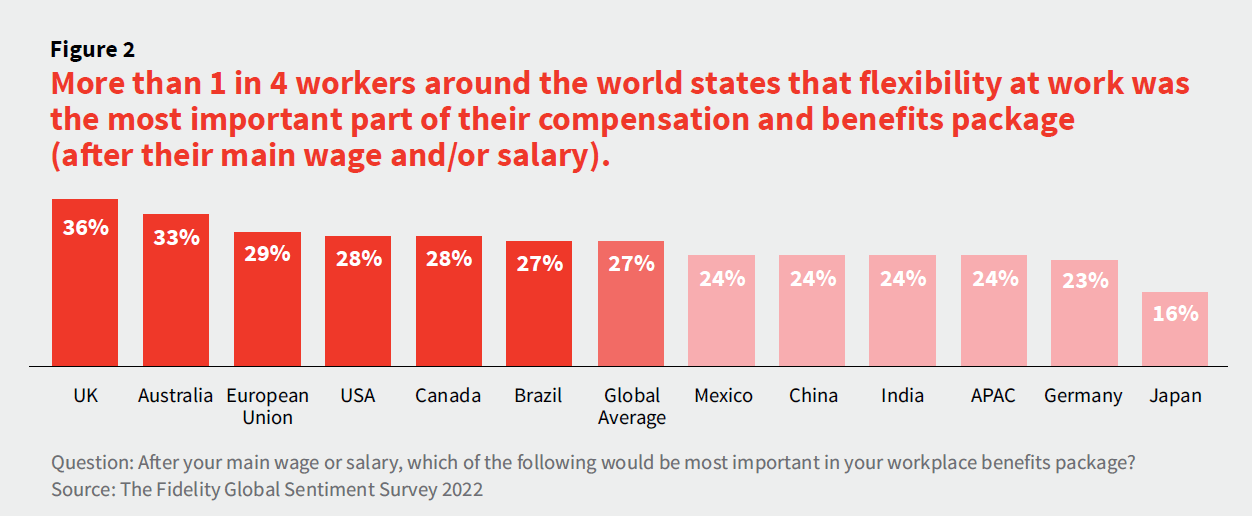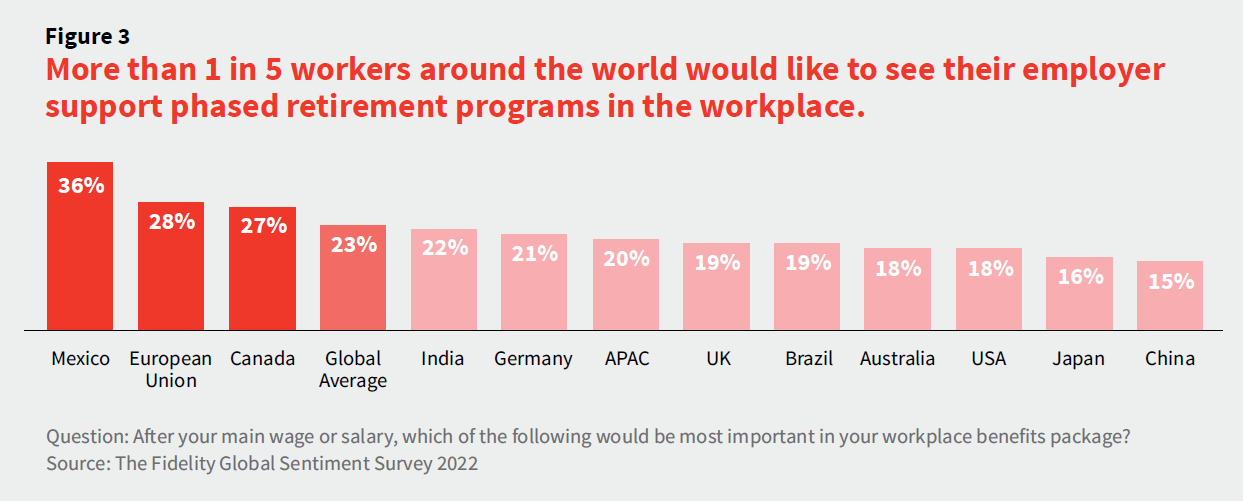Flexibility is Giving Work and Retirement New Meaning

" According to our latest Global Sentiment Survey, which surveys working adults in more than 20 international regions, flexibility in the workplace is a top offering that workers want to see."
Ali M. Ahmed
Director, Global Thought Leadership
Fidelity Investments
Download PDF
To understand the working landscape, we asked more than a thousand senior leaders from multinational companies all over the world about their current and future business priorities in our annual Global Employer Survey.[i] This year, we saw many companies, headquartered across the world say that they are focused on attracting, developing, and retaining talent.
Despite the focus on priorities related to talent, our research uncovered that companies say making progress to build and maintain the talent pipeline is challenging and their biggest pain point. There could be a myriad of reasons that may explain why companies are having difficulties finding the “right” talent, such as shrinking budgets, changes to hiring practices (i.e. hiring freezes or layoffs), or even reductions in workforce.
But there could be another reason; some companies are locking out parts of the available talent pool because they are still defining “work” (by extension, who is working for them) through a lens that existed before the COVID-19 pandemic. After all, the pandemic has significantly impacted what workers want in a work experience (Figure 1)[ii] so shouldn’t employers also look to evolve how they choose to define the ways in which work is done?
When was the last time you reviewed your strategy when it comes to defining talent?

For employers who are willing to explore additional definitions of what work means, where do they even start?
When defining what work means at your company, consider starting with the “who” before the “how” and the “what.”
According to the World Health Organization, in less than 10 years, 1 in 6 people will be aged 60 years or older.[iii] With that many individuals reaching traditional retirement ages (between ages 60 and 70 in most economies) soon, we can anticipate a large number of those individuals making the traditional decision to leave the workforce. But, since many workers are negotiating with their employers to let them work on their terms, should we expect that more mature workers will reevaluate when, how, and even if they retire?
From our research, we see many workers want to continue working as they get older, including some workers who may need to continue working for financial reasons. We aren’t the only ones to notice this change in the workforce demographic.
- According to the U.S. Bureau of Labor Statistics, the largest growing segment of the labor force is aged 65-76.[iv]
- Another example can be found in the UK, where the British government is actively advocating workers aged 50 or more to be reengaged in the workforce.[v]
- According to the OECD, Japan already has some of the highest rates of labor force participation for older people amongst many advanced economies.[vi]
- China’s state media has called on the government to encourage more people aged 60 or older to work again.[vii]
That forecast means individuals who are not traditionally expected to continue working actually do and are sometimes even encouraged to work. This should prompt the question: Are you, as an employer, taking advantage of the talent pool of mature workers in a way that resonates with them?
Be flexible about what work means to different kinds of workers.
If you’re in human resources, manage a team, or just work with others, you’ve probably heard others (or yourself) at your firm asking about flexibility at work. And we don’t anticipate that question to go away soon. According to our latest Global Sentiment Survey,[viii] which surveys working adults in more than 20 international regions, flexibility in the workplace is a top offering that workers want to see (Figure 2).[ix]

Despite the popularity and prevalence of flexibility at work, defining flexibility strategies may be challenging for some employers as well as some employees. Flexibility can look different from country to country, region to region, industry to industry, company to company, business unit to business unit, team to team, and even amongst individuals on the same team. As offices and other types of physical workspaces open back up (also acknowledging some of them never physically closed during the height of the pandemic), we must recognize that flexibility at work may exist in different forms and isn’t only about working from home or another employer-operated location. To craft a valuable definition of what one type of flexibility at work could mean at their company, we encourage employers to turn to workers to understand better what types of flexibility are valued.
How can you adapt flexibility at work, especially for more mature workers?
If you have experienced a departure or retirement of a seasoned worker, you know it takes time and money to try to replace the skills, the historical knowledge and context of why decisions are made, and the valuable relationships that left with that worker. But what if the decision to leave or retire was less rigid and more flexible by design? (Figure 3).[x]

Historically, the decision to retire from a company was a shift from working full-time to not working at all. As highlighted earlier in this piece, older workers still continue to work. But, as an employer, you may have encouraged them to work elsewhere by not employing flexibility in how the decision to retire is made at your company.
Let’s consider what could be gained by both employers and workers by reimagining how retirement is done within your firm (Figure 4).
Figure 4
Both employers and workers may find advantages by enacting phased retirement programs.
Advantages for employers to support phased retirement programs
- Potentially reinforce a culture that fosters diversity, equity, and inclusion by honoring experience and tenure.
- May create new paths for career advancement for mature workers to lead and train others within the company.
- Possibly reduce the impact of knowledge loss within the firm.
- May encourage employee loyalty in a new way and may strengthen employee well-being by supporting workers’ needs.
- Temporarily fill in labor gaps when full-time workers may take leave or exit the organization or a spike in customer demand.
- Potentially encourage to keep retirement assets within employer-sponsored plan, which may lead to more cost-efficient benefits.
Advantages for workers to participate in phased retirement
-
Potentially meet the need for flexibility in the workplace, even at later stages of career.
-
May bolster financial wellness as more mature workers still have an opportunity to earn pay.
-
May strengthen well-being with meaningful and purposeful work.
-
Potentially encourage new skills development based on type of work.
In a competitive talent market, it’s not a sound strategy to exclude a portion of the available workforce because of what tradition or an archaic policy dictates. Employers must take advantage of the skills and knowledge that can only be ascertained by a lifetime of experience.
[i] The Fidelity Global Employer Survey 2023. The survey sample consisted of 1,002 senior leaders at U.S. and non-U.S. based MNCs where the company has a presence in two or more international markets (average = 10), employs at least 1,000 workers, is for-profit or non-profit (government bodies were excluded), in some cases there may be responses from more than one senior leader from a particular company. The survey was conducted by Dynata, a third-party market research company using their global research panel in conjunction with their partner vendors. The survey was fielded in March 2023.
[ii] Internal Fidelity survey of 2,334 U.S. plan participants fielded Nov. 5 - 11, 2021
[viii] The Fidelity Global Sentiment Survey is an annual study of attitudes and actions of employees in four areas: well-being, financial habits, retirement, and work. The survey was first launched in 2021 with the 2022 survey providing extensive information from 20,000 employees in 17 regions. The data collection, research and analysis for the above markets was completed in partnership with Opinium, a strategic insight agency. Data collection took place between August 2022 and September 2022. Reporting and analysis took place between August 2022 and October 2022.
[ix] The Fidelity Global Sentiment Survey 2022
[x] The Fidelity Global Sentiment Survey 2022